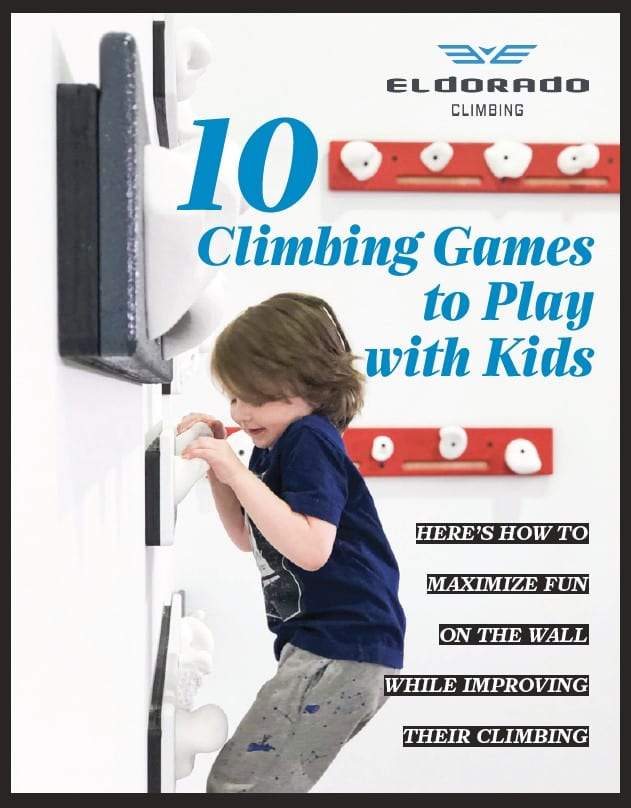10 Climbing Games for Kids

Here's how to maximize fun on the wall while improving their climbing.
Kids can make a game out of anything.
Let them loose near a climbing wall and they’ll pretend to be Spider-Man or Spider-Woman. But they also tend to have short attention spans and may be just as psyched to swing around on the ropes or chase each other across the bouldering mats as they are to climb.
That said, there are actually some great ways to make climbing interesting and engaging—and non-threatening—for your little ones. We recommend the following 10 awesome games, delivered to us by climbing gym owners, coaches and parents, to play with kids of all ages on the wall to keep them engaged (so they don’t start a game of chase), improve their climbing, and most importantly, have a ton of fun.
FREE Download
Game: ADD-ON
Number of Players: 2+
Best ages: Any
Best played on: A bouldering wall, since leaders/climbers change often
Why play: Work on weaknesses, route-finding, endurance
Start Here>> The first player, or the leader (either one kid in the group or the leader/instructor/parent), begins at a friendly start-ing hold and does a sequence of two to three moves all players can do. From there, the next player then tries the newly established route, adding on a move of their own at the end of the sequence, then the next climber takes a turn, adding another move, and so on. If a player can’t do the add-on, they lose a life. Three lost lives means the player is eliminated. Switch up who starts/gets to be the leader.
2
Game: OCTOPUS Number of players: Small group Best ages: Toddler to young/beginner Best played on: Bouldering wall, TacTiles at-home wall Why play: Work on grip strength, creative footwork, flexibility; have fun on even a small section of wall, like on home gyms built with TacTiles
Start here>> The player grabs a jug, and then reaches as many holds with just their feet that they can, without releasing their grip on the handhold. Score one point for each hold reached.
3
Game: FUZZ-BALL SEARCH
Number of players: Any
Best played: On a route or bouldering wall
Best ages: Any (see variations)
Why play: Minimize fear on the wall, work on endurance, increase playfulness
Start here>> The leader/instructor/parent hides little fuzz balls, or pom-poms (or any similar small items—toy cars, plastic dinosaurs, Hershey’s Kisses), on holds. The child then climbs up or traverses across to look for them. The leader can set parameters about how the child is allowed to find them, for instance telling the child they must have both feet on the wall when they find one. Another parameter would be that each climber can only find one pom-pom per route. Have climbers downclimb once they find their pom-pom, which teaches them good balance and effective footwork.
Variation>> To make this more challenging, make different colored pom-poms worth different amounts of points.
Variation>> This also can also be done by having kids work in teams, if they’re old enough.
4
Game: PUZZLE PIECES
Number of players: 2+
Best ages: Any
Why play: Build teamwork and camaraderie while improving all-around climbing strength
Start here>> Hide puzzle pieces on holds on a certain route or a section of a bouldering wall. Have the climber, or group of climbers, put the puzzle together once the pieces are all found. You can vary the puzzle difficulty based on the ages of the children.
5
Game: DRESS-UP
Number of players: Any
Best ages: Any
Why play: Improve endurance, find creative rest positions
Best played: Like “Fuzz Ball Search,” and “Puzzle Pieces,” the leader places items like hats, glasses, and even gloves on holds. Kids climb to each item, then put them on, being sure to keep any dangling items safely out of the way. Save the most challenging items—like shirts—for the top of the wall.
6
Game: SIMON SAYS
Number of Players: Any
Best ages: Any
Best played: On a bouldering wall
Why play: Improve creative thinking while gaining strength
Start here>> A leader (“Simon”) gives a group a timeframe of 15 seconds to find a spot on the wall where they’re holding on with all four limbs—both hands and both feet. Then Simon gives a directive, like, “Move your left foot.” All climbers have to move their left foot to find a new hold, and so-on. The game ends when there is one player remaining on the wall after the others have fallen off or when the others are unable to secure them-selves on the directed hold.
7
Game: BLINDFOLDED CLIMBING
Number of players: 2
Best ages: Older/more advanced
Best played: On a route with a belayer; TacTiles at-home wall
Why play: Learn to climb by feel and listen to cues, improve communication and trust, improve balance; have fun on even a small section of wall, like on home gyms built with TacTiles
Start here>> The climber wears a blindfold, and the belayer must give the climber verbal instructions on where to find the holds. The climber remains blindfolded throughout the entire climb. The climber then switches with the belayer, and the game is repeated.
Variation>> Lose the blindfold and adapt to climbing only with one hand by placing your hand behind your back or holding a tennis ball, while still using the elbow of that arm. Or use only one foot (though don’t use knees).
* Adaptive climbers can do amazing things in rock climbing. Eldo Walls donates 5% of sales of our TacTiles to Paradox Sports to support their adaptive climbing program.
8
Game: GYM TWISTER
Number of players: Small groups: 3 or 4
Best ages: Older/more advanced
Best played: On a route with many holds, or on a bouldering wall
Why play: Build endurance, strength, and balance
Start here>> Climbers are spread out autobelays or in the bouldering area. Use the spin-ner board from the board game Twister, or use pieces of paper on which you’ve written the cues “Right hand,” “left hand,” “right foot,” “left foot,” and put them into a hat or pile, with another hat or pile containing pieces of paper listing the colors of the holds. Either spin the Twister spinner or pull one piece of paper from each pile, then call out the direc-tions. As with regular Twister, once you fall/topple you’re out of the game.
Variation>> To make this harder, write the hold type (“pinch,” “crimper,” “sloper,” etc.) on more pieces of paper, making a third pile. Or combine the hold type with the hold color—for instance, “Red crimper.”
Variation>> To make this harder still, play Gym Twister on an overhanging wall.
9
Game: SHAKEOUT STREET
Number of players: Small groups—3 or 4
Best ages: 6–16
Best played: On a route with many holds, or on a bouldering wall
Why play: Learn to find rest positions
Start here>> Climbers are spread out autobelays or in the bouldering area. Use the spin-ner board from the board game Twister, or use pieces of paper on which you’ve written the cues “Right hand,” “left hand,” “right foot,” “left foot,” and put them into a hat or pile, with another hat or pile containing pieces of paper listing the colors of the holds. Either spin the Twister spinner or pull one piece of paper from each pile, then call out the direc-tions. As with regular Twister, once you fall/topple you’re out of the game.
Variation>> To make this harder, write the hold type (“pinch,” “crimper,” “sloper,” etc.) on more pieces of paper, making a third pile. Or combine the hold type with the hold color—for instance, “Red crimper.”
Variation>> To make this harder still, play Gym Twister on an overhanging wall.
10
Game: FARTLEK
Number of players: Any
Best ages: Intermediate–advanced
Best played: On routes or bouldering walls
Why play: This game, which is Swedish for “speed play,” teaches kids to vary their pac-es, and to not just climb at one speed. (Plus, kids will say, “You had me at ‘fart,’” and you’ll get lots of giggles.)
Start here>> The climber de-cides when to sprint and when to slow down, yelling down to their belayer when they’re changing paces. Or, the coach yells to kids on the wall when to speed up and when to slow down.
Special thanks to Laurie Normandeau at the Boulder Rock Club, Mike O’Connor from the Santa Barbara Rock Gym and Climbing.com for suggestions and ideas.





Leave a comment